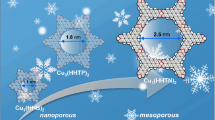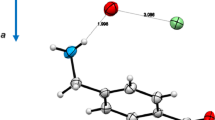Abstract
Four 3d–4f heterometallic complexes, [CuIILnIII(bpt)2(NO3)3(MeOH)] (Ln = Gd, 1; Dy, 2; bptH = 3,5-bis(pyrid-2-yl)-1,2,4- triazole), [CuII 2LnIII 2(µ-OH)2(bpt)4Cl4 (H2O)2]·6H2O (Ln = Gd, 3; Dy, 4), have been synthesized under solvothermal conditions. X-ray structural analyses reveal that 1 and 2 are isostructural while 3 and 4 are isostructural. In each complex, the copper and gadolinium or dysprosium ions are linked by two triazolate bridges and form a CuII-LnIII dinuclear unit. The intramolecular Cu-Ln distances are 4.542, 4.525, 4.545 and 4.538 Å for 1, 2, 3 and 4, respectively. Two dinuclear CuLn units are bridged by two OH− groups into the zig-zag tetranuclear {CuII 2LnIII 2} structures with the Ln(III)...Ln(III) distances of 3.742 and 3.684 Å for 3 and 4, respectively. Magnetic studies show that the antiferromagnetic CuII-LnIII interactions occur in 1 (J CuGd = −0.21 cm−1) and 2. The antiferromagnetic interaction occurs in complex 3 with J CuGd = −0.82 cm−1 and J GdGd = −0.065 cm−1, while dominant ferromagnetic interaction occurs in complex 4.
Similar content being viewed by others
References
Winpenny REP. The structures and magnetic properties of complexes containing 3d- and 4f-metals. Chem Soc Rev, 1998, 27: 447–452
Piguet C, Bunzli JCG. Mono- and polymetallic lanthanide-containing functional assemblies: A field between tradition and novelty. Chem Soc Rev, 1999, 28: 347–358
Kahn O. Chemistry and physics of supramolecular magnetic materials. Acc Chem Res, 2000, 33: 647–657
Sakamoto M, Manseki K, Okawa H. d-f Heteronuclear complexes: Synthesis, structures and physicochemical aspects. Coord Chem Rev, 2001, 219–221: 379–414
Benelli C, Gatteschi D. Magnetism of lanthanides in molecular materials with transition-metal ions and organic radicals. Chem Rev, 2002, 102: 2369–2387
Kou HZ, Zhou BC, Gao S, Wang RJ. A 2D cyano- and oxamidato-bridged heterotrimetallic CrIII-CuII-GdIII complex. Angew Chem Int Ed, 2003, 42: 3288–3291
Osa S, Kido T, Matsumoto N, Re N, Pochaba A, Mrozinski J. A tetranuclear 3d–4f single molecule magnet: [CuIILTbIII(hfac)2]2. J Am Chem Soc, 2004, 126: 420–421
Zaleski CM, Depperman EC, Kampf JW, Kirk ML, Pecoraro VL. Synthesis, structure, and magnetic properties of a large lanthanide-transition-metal single-molecule magnet. Angew Chem Int Ed, 2004, 43: 3912–3914
Sangregorio LC, Sessoli R, Gatteschi D. Molecular engineering for single-chain-magnet behavior in a one-dimensional dysprosiumnitronyl nitroxide compound. Angew Chem Int Ed, 2005, 44: 5817–5821
Yukawa Y, Aromi G, Igarashi S, Ribas J, Zvyagin SA, Krzystek J. [GdNi6] and [LaNi6]: High-field epr spectroscopy and magnetic studies of exchange-coupled octahedral clusters. Angew Chem Int Ed, 2005, 44: 1997–2001
He Z, He C, Gao EQ, Wang ZM, Yang XF, Liao CS, Yan CH. Lanthanide-transition heterometallic extended structures with novel orthogonal metalloligand as building block. Inorg Chem, 2003, 42: 2206–2208
Zhang JJ, Hu SM, Xiang SC, Sheng TL, Wu XT, Li YM. Syntheses, structures, and properties of high-nuclear 3d–4f clusters with amino acid as ligand: {Gd6Cu24}, {Tb6Cu26}, and {(Ln6Cu24)2Cu} (Ln = Sm, Gd). Inorg Chem, 2006, 45: 7173–7181
Liu FC, Zeng YF, Jiao J, Li JR, Bu XH, Ribas J, Batten SR. Novel heterometallic 3d–4f metal-azido complex of mixed ligands with unprecedented structure type: Synthesis, structure, and magnetic properties. Inorg Chem, 2006, 45: 6129–6131
Aronica C, Chastane G, Pilet G, Guennic B, Robert LV, Wernsdorfer W, Luneau D. Cubane variations: Syntheses, structures, and magnetic property analyses of lanthanide(III)-copper(II) architectures with controlled nuclearities. Inorg Chem, 2007, 46: 6108–6119
Chandrasekhar V, Pandian BM, Boomishankar R, Steiner A, Vittal JJ, Houri A, Clerac R. Trinuclear heterobimetallic Ni2Ln complexes [L2Ni2Ln][ClO4] (Ln = La, Ce, Pr, Nd, Sm, Eu, Gd, Tb, Dy, Ho, and Er; LH3 = (S)P[N(Me)NCH-C6H3-2-OH-3-OMe]3): From simple paramagnetic complexes to single-molecule magnet behavior. Inorg Chem, 2008, 47: 4918–4929
Schray Dirk, Abbas G, Lan YH, Mereacre V, Sundt A, Dreiser J, Waldmann O, Kostakis GE, Anson CE, Powell AK. Combined magnetic susceptibility measurements and 57Fe mössbauer spectroscopy on a ferromagnetic {FeIII 4Dy4} ring. Angew Chem Int Ed, 2010, 49: 5185–5188
Bencini A, Benelli C, Caneschi A, Carlin RL, Dei A, Gatteschi D. Crystal and molecular structure of and magnetic coupling in two complexes containing gadolinium(III) and copper(II) ions. J Am Chem Soc, 1985, 107: 8128–8136
Benelli C, Caneschi A, Gatteschi D, Guillou O, Pardi L. Synthesis, crystal structure, and magnetic properties of tetranuclear complexes containing exchange-coupled dilanthanide-dicopper (lanthanide = gadolinium, dysprosium) species. Inorg Chem, 1990, 29: 1750–1755
Kahn ML, Mathoniere C, Kahn O. Nature of the interaction between LnIII and CuII ions in the ladder-type compounds {Ln2[Cu(opba)]3}·S (Ln = lanthanide element; opba = ortho-phenylenebis(oxamato), S = solvent molecules). Inorg Chem, 1999, 38: 3692–3697
Liang Y, Cao R, Su W, Hong M, Zhang W. Syntheses, structures, and magnetic properties of two gadolinium(III)-copper(II) coordination polymers by a hydrothermal reaction. Angew Chem Int Ed, 2000, 39: 3304–3307
Figuerola A, Diaz C, Fallash MSE, Ribas J, Maestro M, Mahfa J. Structure and magnetism of the first cyano-bridged hetero-one-dimensional GdIII-CrIII complexes. Chem Commun, 2001, 1204–1205
Paulovic J, Cimpoesu F, Ferbinteanu M, Hirao K. Mechanism of ferromagnetic coupling in copper(II)-gadolinium(III) complexes. J Am Chem Soc, 2004, 126: 3321–3331
Costes JP, Dahan F, Dupuis A. Is ferromagnetism an intrinsic property of the CuII/GdIII couple? 2. Structures and magnetic properties of novel trinuclear complexes with µ-phenolato-µ-oximato (Cu-Ln-Cu) cores (Ln = La, Ce, Gd). Inorg Chem, 2000, 39: 5994–6000
Madalan AM, Roesky HW, Andruh M, Noltemeyer M, Stanica N. The first coordination compound containing three different types of spin carriers: 2p-3d–4f (TCNQ·−, Cu2+ and Gd3+). Chem Commun, 2002, 1638–1639
Kido T, Ikuta Y, Sunatsuki Y, Ogawa Y, Matsumoto N. Nature of copper(II)-lanthanide(III) magnetic interactions and generation of a large magnetic moment with magnetic anisotropy of 3d–4f cyclic cylindrical tetranuclear complexes [CuIILLnIII(hfac)2]2, (H3L=1-(2-Hydroxybenzamido)-2-(2-hydroxy-3-methoxybenzylideneamino)ethane and Hhfac = hexafluoroacetylacetone, LnIII = Eu, Gd, Tb, Dy). Inorg Chem, 2003, 42: 398–408
Zhang L, Wang SB, Yang GM, Tang JK, Liao DZ, Jiang ZH, Yan SP, Cheng P. A ferromagnetically coupled CrCu3 tetramer and GdCu4 pentamer with a [15]N4 macrocylic ligand incorporating an oxamido bridge. Inorg Chem, 2003, 42: 1462–1466
Mishra A, Wernsdorfer W, Parsons S, Christou G, Brechin EK. The search for 3d–4f single-molecule magnets: synthesis, structure and magnetic properties of a [MnIII 2DyIII 2] cluster. Chem Commun, 2005. 2086–2088
Novitchi G, Wernsdorfer W, Chibotaru LF, Costes JP, Anson CE, Powell AK. Supramolecular “double-propeller” dimers of hexanuclear CuII/LnIII complexes: A {Cu3Dy3}2 single-molecule magnet. Angew Chem Int Ed, 2009, 48: 1614–1619
Mori F, Nyui T, Ishida T, Nogami T, Choi KY, Nojiri H. Oximate-bridged trinuclear Dy-Cu-Dy complex behaving as a single-molecule magnet and its mechanistic investigation. J Am Chem Soc, 2006, 128: 1440–1441
Schneider CJ, Cashion JD, Moubaraki B, Neville SM, Batten SR, Turner DR, Murray KS. The magnetic and structural elucidation of 3,5-bis(2-pyridyl)-1,2,4-triazolate-bridged dinuclear iron(II) spin crossover compounds. Polyhedron, 2007, 26: 1764–1772
Chen JC, Hu S, Zhou AJ, Tong ML, Tong YX. Synthesis, crystal structures, and magnetic properties of three new iron complexes derived from 3,5-bis(pyridin-2-yl)-1,2,4-triazole. Z Anorg Allg Chem, 2006, 632: 475–481
Meng ZS, Yun L, Zhang WX, Hong CG, Herchel R, Ou YC, Leng JD, Peng MX, Lin ZJ, Tong ML. Reactivity of 4-amino-3,5-bis(pyridin-2-yl)-1,2,4-triazole, structures and magnetic properties of polynuclear and polymeric Mn(II), Cu(II) and Cd(II) complexes. Dalton Trans, 2009. 10284–10295
Cheng L, Zhang WX, Ye BH, Lin JB, Chen XM. Spin canting and topological ferrimagnetism in two manganese(II) coordination polymers generated by in situ solvothermal ligand reactions. Eur J Inorg Chem, 2007, 2668–2676
Zhang JP, Lin YY, Huang XC, Chen XM. Molecular chairs, zippers, zigzag and helical chains: chemical enumeration of supramolecular isomerism based on a predesigned metal-organic building-block. Chem Commun, 2005, 1258–1260
Bao X, Leng JD, Meng ZS, Lin ZJ, Tong ML, Nihei M, Oshio H. Tuning the spin states of two apical iron(II) ions in the trigonal-bipyramidal [{FeII(µ-bpt)3}2FeII 3(µ3-O)]2+ cations through the choice of anions. Chem Eur J, 2010, 16: 6169–6174
Zhang JP, Lin YY, Huang XC, Chen XM. Copper(I) 1,2,4-triazolates and related complexes: Studies of the solvothermal ligand reactions, network topologies, and photoluminescence properties. J Am Chem Soc, 2005, 127: 5495–5506
Tong ML, Hong CG, Zheng LL, Peng MX, Gaita-Arińo A, Clemente-Juan JM. New reactivity of 4-amino-3,5-bis(pyridin-2-yl)-1,2,4-triazole: Synthesis and structure of a mononuclear species, a dinuclear species, and a novel tetranuclear nickel(II) rectangle box, and magnetic properties of the dinuclear and tetranuclear complexes. Eur J Inorg Chem, 2007. 3710–3717
Yucesan G, Yu MH, Ouellette W, O’Connor CJ, Zubieta J. Secondary metal-ligand cationic subunits {ML}n+ as structural determinants in the oxovanadium/phenylphosphonate/{ML}n+ system, where {ML} is a Cu2+/organonitrogen moiety. CrystEngComm, 2005, 7: 480–490
Guo PH, Liu JL, Zhang ZM, Ungur L, Chibotaru LF, Leng JD, Guo FS, Tong ML. The first {Dy4} single-molecule magnet with a toroidal magnetic moment in the ground state. Inorg Chem, 2012, 51: 1233–1235
CrysAlis RED, version 1.1, Oxford Diffraction Ltd., 2003
Sheldrick GM. SHELXTL-97, Universität of Göttingen: Göttingen, Germany, 1997
Bradenburg K. Diamond. ver3.1, Crystal Impact, Germany, 2005
Kahn O. Molecular Magnetism, 1993
Chiboub Fellah FZ, Costes JP, Dahan F, Duhayon C, Novitchi G, Tuchagues JP, Vendier L. Di- and triheteronuclear Cu-Gd and Cu-Gd-Cu complexes with dissymmetric double bridge. Inorg Chem, 2008, 47: 6444–6451
Akine S, Matsumoto T, Taniguchi T, Nabeshima T. Synthesis, structures, and magnetic properties of tri- and dinuclear copper(II)-gado-linium(III) complexes of linear oligooxime ligands. Inorg Chem, 2005, 44: 3270–3274
Madalan AM, Avarvari N, Fourmigué M, Clérac R, Chibotaru LF, Clima S, Andruh M. Heterospin systems constructed from [Cu2Ln]3+ and [Ni(mnt)2]1−,2− tectons: First 3p-3d–4f complexes (mnt = Maleonitriledithiolato). Inorg Chem, 2008, 47: 940–950
Richardson MF, Wagner WF, Sands DE. Rare-earth trishexafluoroacetylacetonates and related compounds. J Inorg Nucl Chem, 1968, 30: 1275–1289
Tang JK, Hewitt I, Madhu NT, Chastanet G, Wernsdorfer W, Anson CE, Benelli C, Sessoli R, Powell AK. Dysprosium triangles showing single-molecule magnet behavior of thermally excited spin states. Angew Chem, 2006, 118: 1761–1765; Angew Chem Int Ed, 2006, 45: 1729–1733
Borrás-Almenar JJ, Clemente-Juan JM, Coronado E, Tsukerblat BS. High-nuclearity magnetic clusters: Generalized spin hamiltonian and its use for the calculation of the energy levels, bulk magnetic properties, and inelastic neutron scattering spectra. Inorg Chem, 1999, 38: 6081–6088
Author information
Authors and Affiliations
Corresponding author
Rights and permissions
About this article
Cite this article
Zhang, Z., Guo, F., Guo, P. et al. Di- and tetranuclear heterometallic CuII-LnIII complexes (Ln = Gd and Dy): Synthesis, structure and magnetic properties. Sci. China Chem. 55, 934–941 (2012). https://doi.org/10.1007/s11426-012-4564-3
Received:
Accepted:
Published:
Issue Date:
DOI: https://doi.org/10.1007/s11426-012-4564-3




